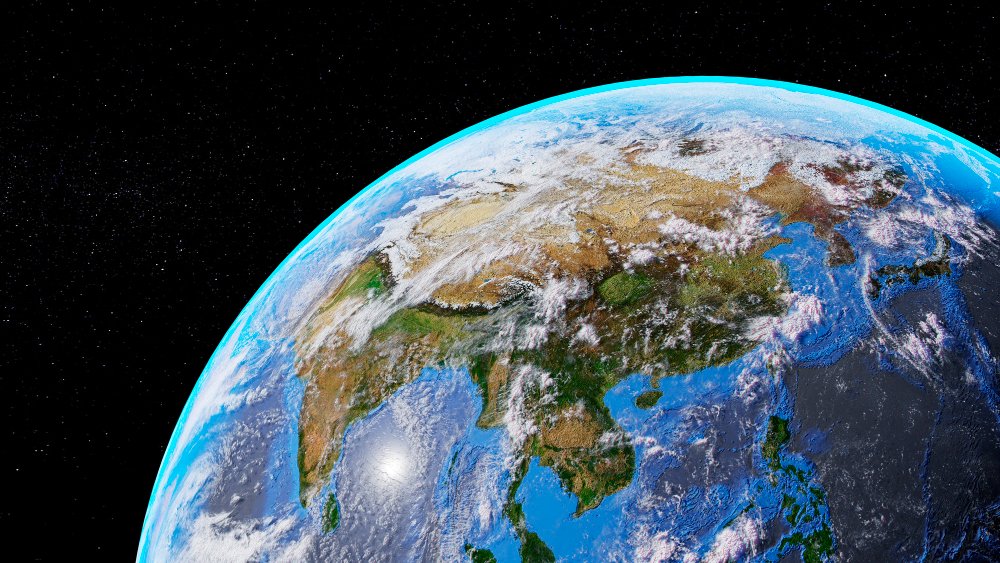OBSERVING THE UNIVERSE
What is space?
We live on a small, blue planet called Earth.
It has a surface of liquid water and rock and
is surrounded by a blanket of air called the
atmosphere. Space begins at the top of the
atmosphere. It is an unimaginably vast,
silent, and largely empty place, but it has
many amazing properties. Blacker than black
In photos taken from space, our planet is
surrounded by blackness. This shows how empty outer space is. Planets like Earth shine because they reflect light from the Sun. Stars shine because they produce huge amounts of energy by burning fuel. Most of space looks black because there is nothing there to produce or reflect light.
THE EDGE OF SPACE
Earth’s atmosphere does not end
suddenly—it gets gradually thinner
and thinner as you travel up from the
ground. Most experts agree that outer
space starts at a height of 60 miles
(100 km). Yet even above this height,
there is a layer of very thin air called
the exosphere. Hydrogen and other
light gases are slowly escaping into
space from this outermost part
of Earth’s atmosphere.
FACT FILE
■ In the US, anyone who flies above an
altitude of 60 miles (100 km) in a rocket or
spacecraft gets a special badge called
“astronaut wings.”
■ Our most common name for people who
travel into space is “astronauts,” meaning
star travelers. The Russians call them
“cosmonauts,” meaning travelers through
the universe, and the Chinese name is
“taikonauts,” from their word for space.
■ A person who stepped out into space
without a protective suit would quickly die.
He or she would be unable to breathe, but
would still have around 10 seconds to
reach safety before losing consciousness.
, THE ATMOSPHERE protects
Earth’s surface from harmful radiationand the full heat of the Sun. At night,
it stops heat from escaping into space.
IN A VACUUMA place without any air or gas is called a
vacuum. On Earth, air transfers heat from
one place to another. In space, there is no
air to distribute heat, so the sunlit side of a
spacecraft gets very hot, while the other side is in darkness and gets very cold. Spacecraft have to be tested in a thermal vacuum chamber before they are launched to make sure that they can survive these extreme space temperatures.
Sun u ESCAPING GRAVITY
The space shuttle uses up all the fuel in its two booster rockets just to overcome gravity
and reach outer space. Getting off the groundIt is difficult to get into space because Earth’s gravity holds everything down. To overcome gravity and go into orbit, a rocket has to reach a speed of 17,500 mph (28,000 km/h), known as escape velocity. This requires a lot of fuel to provide energy. To reach the Moon and planets, spacecraft have to travel at an even higher speed—25,000 mph (40,000 km/h).Our place in spacePlanet Earth is our home and to us it seems a very bigplace. Flying to the other side of the world takes anentire day, and sailing around the world takes manyweeks. Yet in the vastness of the universe, Earth isjust a tiny dot. In fact, an alien flying through our galaxy would probably not even notice our little planet.
EARTH AND MOONEarth’s nearest neighbor is the Moon, ourplanet’s only natural satellite. The Moon isa lot smaller than Earth. Its diameter isonly about one-quarter the diameter ofEarth, and fifty Moons would fit insideEarth. Although it looks quite close, theMoon is actually about 240,000 miles(384,000 km) away. It takes a mannedspacecraft three days to travel from Earthto the Moon.THE SOLAR SYSTEM
Earth is just one of many objects that orbit the star we call theSun. The Sun’s “family” consists of eight planets, five dwarfplanets, hundreds of moons, millions of comets and asteroids,and lots of gas and dust. All these things together are called thesolar system. The four small planets closest to the Sun are madeof rock, while the four outer planets are a lot larger and mademostly of gases. Earth is the third planet out from the Sun andis just the right temperature to support life. The solar system isbig—the Voyager spacecraft took 12 years to reach Neptune,the outermost planet.
THE LOCAL GROUP
The Milky Way is one of the largest galaxies in a clusterof about 45 galaxies, known as the Local Group. Mostof these galaxies have no particular shape and are muchsmaller than the Milky Way. The two closest galaxies to theMilky Way are called the Large and the Small MagellanicClouds. They lie about 200,000 light-years away and areeasily visible with the naked eye from Earth’s southernhemisphere. The biggest galaxy in the Local Group is theAndromeda Galaxy—a great spiral galaxy, much like theMilky Way. It lies about 3 million light-years away, in the constellation of Andromeda.
THE UNIVERSE
The universe is everything that exists—all the stars, planets, galaxies, and the space between them. There are millions of galaxy clusters in the universe:
in fact, wherever we look with
telescopes, the sky is full of
galaxies. And scientists estimate
that there must be about 10
thousand billion billion stars in
the universe—more than the
number of grains of sand on all
the beaches on Earth.
THE MILKY WAY
The solar system is located in a large spiral-shaped galaxy called
the Milky Way and lies about 30,000 light-years from the center
of the galaxy. The Sun is just one of at least 100 billion stars in
this galaxy. The Milky Way is vast—it measures about 100,000
light-years across. That means that a spaceship traveling at the
speed of light (186,000 miles or 300,000 km per second) would
take 100,000 years to fly from one side of the galaxy to the
other. The Milky Way is so big that the stars in it are usually
a long way apart. The nearest star to our Sun is more than 4light-years away.
Early ideas
Compared with everything else around us, Earth seems incredibly large.
Ancient peoples believed it was the biggest and most important place in the
universe and that everything revolved around it. These ideas only began to
change very slowly after the introduction of the telescope in the early 1600s.
Curving surface
of Earth
Line of sight
d LAND AHOY! As the boat gets closer to the island, the
sailor sees the tops of the mountains first. Then, as the boat
moves over the curve, lower land comes into view.
Ancient peoples watched the Sun, Moon,
and stars very carefully. They saw that
all of them traveled from east to
west across the sky. Clearly, they
were all going around a stationary
Earth. For several thousand years,
almost everyone believed that the Earth
was at the center of the universe. The
main problem with this idea was that
it did not explain the movements of
some of the planets—sometimes Mars
or Jupiter appeared to stand still or
even move backward.
EARTH-CENTERED UNIVERSE
Earth
Sun
FLAT EARTH OR ROUND EARTH?
Stand on the seashore and look at the horizon. It
seems to be flat. For a long time, people thought
that Earth was flat and that if you went too far you
would fall off the edge. However, it was gradually
realized that Earth was round, like a giant ball.
Nature provided several clues:
■ The shadow that the Earth casts on the Moon during a lunar eclipse is curved, not straight.
■ A sailor traveling due north or south sees stars appear and disappear over the horizon. On a flat Earth, he would always see the same stars.
■ A ship sailing over the horizon should simply get smaller and smaller if Earth is flat. In fact, the hull disappears first and the top of the sails last.
Telescopes
Telescopes are instruments for looking
at things that are far away. Almost
everything we know about space has
been discovered by looking through
telescopes. Optical telescopes can
capture light from the deepest parts
of space, but are limited by the size
of their mirrors and lenses.
. THE YERKES OBSERVATORY was
funded by business tycoon Charles T. Yerkes, who had made his fortune developing Chicago’s mass-transit system.
REFRACTING TELESCOPE
The first telescopes were refracting telescopes, which used lenses to bend and focus light. The biggest refracting telescope is at Yerkes Observatory in Wisconsin. Built in 1897, it is still used for looking at stars and tracking their movements through space.
EVEN BIGGER TELESCOPES
Although reflecting telescopes can be built much
bigger than refracting telescopes, they too will have
problems if the mirror is more than 27 ft (8 m)
across. Astronomers solve this problem by
using a number of smaller mirrors that can
be fitted together to make one big mirror.
Each mirror section is controlled by a
computer that can adjust its position by
less than the width of a human hair.
Giant telescopes
The Hale telescope caused quite a stir when it was completed in 1948.
Equipped with a 16 ft (5 m) mirror, it was the largest and most
powerful telescope ever built. As technology has improved, telescopes
have been built with mirrors up to 33 ft (10 m) across. Even larger
telescopes are now planned, with mirrors of 100 ft (30 m) or more.
Keck Telescopes
■ Size of primary mirror 16 ft (5 m)
■ Location Palomar Mountain, California
■ Altitude 5,580 ft (1,700 m)
Even today, more than 60 years after
it was built, the Hale telescope is the
second-largest telescope using mirrors
made of a single piece of glass. Mirrors
much larger than this tend to sag under their own weight, distorting the image received.
Hale Telescope
■ Size of primary mirror 33 ft (10 m)
■ Location Mauna Kea, Hawaii
■ Altitude 13,600 ft (4,145 m)
Until 2009, the twin Keck telescopes
were the world’s largest optical
telescopes. The Keck II telescope
overcomes the distorting effects of
the atmosphere by using a mirror that
changes shape 2,000 times per second.
Size of primary mirror 26 ft (8 m)
■ Location North: Mauna Kea, Hawaii.
South: Cerro Pacho, Chile
■ Altitude North: 13,822 ft (4,213 m).
South: 8,930 ft (2,722 m)
Gemini telescopes
The twin Gemini telescopes are located on each side of the equator. Between them, they can see almost every part of both the northern and southern skies. The two telescopes are linked through a special high-speed internet connection.
■ Size of primary mirror 27 ft (8.2 m)
■ Location Mount Paranal, Chile
■ Altitude 8,645 ft (2,635 m)
Infrared astronomy
We are all familiar with the colors of the rainbow—red, orange, yellow, green, blue, indigo, and violet. These colors are part of what is known as the visible spectrum. Beyond the red end of the spectrum Is infrared light, which we call heat. Although we cannot see infrared Light, we can detect it using special telescopes, which reveal things usually hidden by clouds of dust.
SPITZER SPACE TELESCOPE
Infrared light from space is almost
completely absorbed by Earth’s
atmosphere, so infrared telescopes are
placed on high mountains, on aircraft,
or on satellites. NASA’s Spitzer Space
Telescope is one of the most powerful
infrared observatories. Spitzer took
18 hours and over 11,000 exposures to
compose this image of the Andromeda
Galaxy (below).
American engineer Karl Jansky was the
first to discover radio waves coming from
space, using a homemade antenna in 1931.
Today, scientists use radio waves to learn
about all kinds of objects in space and
have even attempted to contact alien life.
Arecibo
The largest single radio telescope in the world is Arecibo, on the Caribbean island of Puerto Rico. The telescope measures 1,000 ft (305 m) across and its dish is built into a dip in the hillside, with the radio receiver suspended 450 ft (137 m) above like a giant steel spider.
Although Arecibo’s dish doesn’t move, its location near the equator means it can see a wide region of the sky.
RADIO ASTRONOMY
Radio astronomy is the study of objects in space that produce radio waves. Radio waves are like waves of light but are beyond the visible end of the spectrum.
Invisible radio waves are detected by radio telescopes and can then be converted into images for us to see.
Invisible rays
Ultraviolet (UV) light, X-rays, and gamma rays are types of electromagnetic radiation emitted by extremely hot objects. They are invisible and most are absorbed by Earth’s atmosphere, so the best way to view them is with telescopes on high-flying balloons, rockets, or spacecraft.
Flying highAlthough only in the air for six days, this helium balloon, part of a project called Sunrise, helped astronomers to get a unique look in UV light at how the Sun’s magnetic fields form. It lifted a large solar telescope 23 miles ( 37 km) into the sky, high above the obscuring effects of Earth’s atmosphere.
INTEGRAL
The INTEGRAL space observatory is equipped with highly sensitive detectors that can view objects in X-rays, gamma rays, and visible light all at the same time. Sent into space in 2002, it circles Earth every three days on the lookout for explosive GRBs, supernova explosions, and black holes.
SDO
The Solar Dynamics Observatory (SDO) studies the Sun at many different wavelengths, particularly those at the extreme end of UV. Scientists use the data that it collects from its continuous observations to learn more about how solar activity affects life on Earth.
Jupiter calling EarthThe first radio signals from a distant planet were detected from Jupiter in 1955. Since
then, all of the giant gas planets have been shown to produce radio waves. Radio
signals can also be bounced off the rocky planets and asteroids.













[…] are so many big stars in the whole universe. Which is brighter than the Sun and many times […]